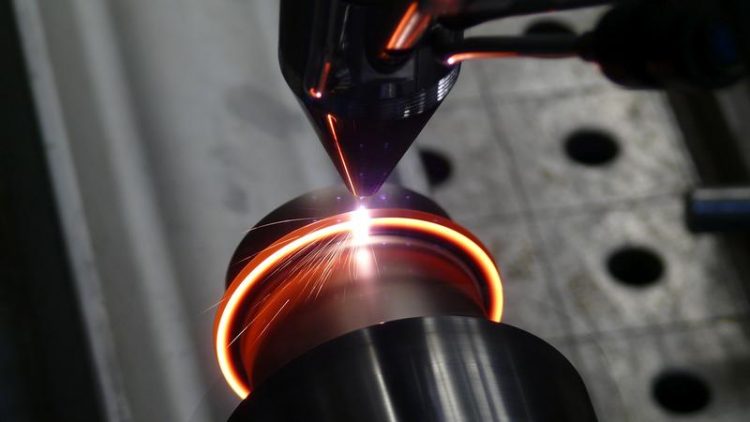ILA 2018: Laser alternative to hexavalent chromium coating

Extreme high-speed Laser Material Deposition (EHLA): protection against wear and corrosion, repair and additive manufacturing – all with only one system technology. © Fraunhofer ILT, Aachen, Germany
When the EU restricted the use of hexavalent chromium compounds to special applications requiring authorization, the move prompted a rethink in the surface technology sector. These restrictions on chromium(VI) entered into force in September 2017.
As an alternative to hard chrome plating, Fraunhofer ILT created the EHLA (extreme high-speed Laser Material Deposition) method. Because the laser fuses powder particles directly in the laser beam, the new technique raises the obtainable process speed from the previous rate of 0.5 to 2.0 meters per minute for laser metal deposition to up to 500 meters per minute.
Another benefit of EHLA is that it needs much less material, as it reduces the coating thickness that can be manufactured from over 500 micrometers to between 25 and 250 micrometers.
Already several 100 offshore cylinders coated
Industry is embracing the Fraunhofer ILT innovation: Since 2015, the Dutch firm IHC Vremac Cylinders B.V. from Apeldoorn has already coated several hundred hydraulic cylinders for offshore use worldwide. The cylinders were up to 10 meters long and up to 500 millimeters in diameter and were coated with wear- and corrosion-resistant alloys for the toughest of conditions. TRUMPF Laser- und Systemtechnik GmbH from Ditzingen now even offers laser systems in its TruLaser Cell series for the EHLA method for various component sizes.
“TRUMPF adopting the technology has hugely expanded the range of customers we can reach with EHLA,” says Thomas Schopphoven, scientist and leader of the Productivity and Systems Engineering team in the Laser Material Deposition group at Fraunhofer ILT. “We’re continuously further developing EHLA into an even more effective and cost efficient process.”
Use in the auto industry
As one of the most prominent and promising applications, the team leader and scientist mentions the possibility of coating car brake disks using EHLA. But the technique could also be used in the aviation industry. Schopphoven explains: “The EHLA method is particularly suitable for the repair of landing gear components, whose anti-corrosion and anti-wear coatings also have to withstand very high stresses, similarly to brake disks.” A video at the Fraunhofer-Gesellschaft booth (Hall 2, Booth 229) will show how the method works.
Contact
Dipl.-Ing. Thomas Schopphoven
Group Productivity & System Technology
Telephone +49 241 8906-8107
thomas.schopphoven@ilt.fraunhofer.de
Dipl.-Ing. Jochen Kittel
Group Additive Manufacturing
Telephone +49 241 8906-136
jochen.kittel@ilt.fraunhofer.de
Media Contact
All latest news from the category: Trade Fair News
Newest articles

A universal framework for spatial biology
SpatialData is a freely accessible tool to unify and integrate data from different omics technologies accounting for spatial information, which can provide holistic insights into health and disease. Biological processes…

How complex biological processes arise
A $20 million grant from the U.S. National Science Foundation (NSF) will support the establishment and operation of the National Synthesis Center for Emergence in the Molecular and Cellular Sciences (NCEMS) at…

Airborne single-photon lidar system achieves high-resolution 3D imaging
Compact, low-power system opens doors for photon-efficient drone and satellite-based environmental monitoring and mapping. Researchers have developed a compact and lightweight single-photon airborne lidar system that can acquire high-resolution 3D…





















